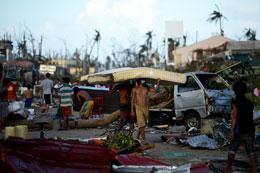Immigration policies need review for climate migrants

Citing natural disasters in the Philippines, Africa and South Asia, a new study co-authored by Simon Fraser University researchers recommends that the federal government create a new immigration class of “climate migrants” to help address the mounting global human displacement associated with climate change.
In "Preparing BC for Climate Migration," the authors also recommend Canada implement immigration targets and programs to ensure the country absorbs its fair share of those migrants.
Released by the Canadian Centre for Policy Alternatives (CCPA) in November, the study reviews Canada’s current immigration policies to determine how they could be better re-engineered, especially in B.C., to help climate migrants.
They are the tens of thousands of people globally, who, since the new millennium, have been displaced from their homes due to climate change-driven natural disasters, such as the 2013 typhoon in the Philippines, that killed thousands of people and affected more than 9 million, the 2010 flash floods in Pakistan that killed 1,800 people and affected 21 million and the drought in Africa that is impacting millions.
Faculty of Health Sciences (FHS) professor Tim Takaro, together with Stephanie Dickson, an alumna and FHS master’s of public health graduate, and Sophie Webber, a University of British Columbia geography doctoral candidate, authored the study.
The trio notes that, while Canada has contributed more than its fair share of emissions that cause climate change, people in the Global South are feeling the harshest impacts of the phenomenon. They live in Africa, Latin America, developing Asia and the Middle East, and have contributed the least to a problem that is forcing them to leave their homes. While some seek to escape through climate migration many remain in a climate-change-devastated homeland and nearby regions.
According to the study, these countries “bear the brunt of the impacts of natural disasters, making up 97 per cent of climate-induced global mortality. It will primarily be populations in the Global South that are temporarily or permanently displaced due to climate change,” says the study.
“Canada has a moral responsibility to people who migrate due to climate change—not just as a matter of charity or generosity, but of justice and reparation as well,” says Takaro, senior author. “The federal and provincial governments, rather than ignoring the issue, should develop a comprehensive policy framework to manage climate migration.”
“Aside from its disproportionate share of the blame for human-caused climate change, Canada’s currently stagnant immigration rate and falling refugee acceptance rates raise issues of fairness about our immigration policies. Is Canada only prepared to accept wealthy immigrants? These are not the people most likely to be forced from their homes by climate change.”
The authors say our federal and provincial governments need to ramp up settlement and other social services, and shore up service-provider organizations to meet this new obligation.
“People who come to Canada as climate migrants should be adding to our existing immigration numbers,” says Dickson. “We need to do better. Currently, the services and organizations that help to settle immigrants are already under stress from inadequate funding—they are barely getting by. Yet, the demands on them will only grow.”
The authors emphasize Canada bears responsibility for helping Global South residents adapt to climate-related stressors in their own country for two more reasons. The residents neither have the resources that richer countries such as Canada have to implement adaptive technologies nor the money to escape to a better-adapted country. The authors say Canada needs to support global efforts for increasing local adaptive capacity.
Meanwhile, as the death toll mounts from Typhoon Hagupit, locally know as Ruby, which hit the Philippines last week, Europe and Canada have expressed readiness to provide relief and assistance to the southeast asain nation.
European Union Commissioner for Humanitarian Aid and Crisis Management Christopher Stylianides praised Philippine authorities, for the massive evacuation of people away from the path of the typhoon.
“Let me commend the Philippine authorities who have taken swift measures and did an excellent job in relocating people from the exposed areas at the first signs of the storm approaching,” Stylianides said in a statement issued last Dec. 5.
He said the EU would send a team of humanitarian experts to support the response and assess the potential needs for assistance.
“The Philippines are not alone as they brace up for a possible hardship,” the EU commissioner also said, adding that the European Commission has been hoping that the impact of the typhoon into the Philippines would be less powerful” than that of Typhoon “Yolanda” (Haiyan).
Canadian Finance Minister Joe Olivier, meanwhile, said that Canada has set aside funding for GlobalMedic, which would respond in support of communities devastated by the typhoon.
Likewise, the Canadian government was ready to deploy relief supplies.
“Canada was a lead donor in response to last year’s Typhoon Haiyan, and as such many of our partners remain on the ground and will have capacity to provide relief efforts,” Olivier said in a statement released by the Canadian embassy in Manila.
“Our thoughts and prayers are with all those put at risk by this powerful typhoon, as people are still coping with painful memories and the destruction wrought by Typhoon Haiyan just over a year ago,” he also said.
He assured the Philippines that the Canadian Armed Forces has started pre-deploying assets toward the region to ensure a swift response and that its Interdepartmental Strategic Support Team would be deployed to make a rapid assessment of the typhoon’s impact.
The civilian-military team would make recommendations “on how Canada can support those in need and help the government of the Philippines to address the immediate impacts of the disaster,” Olivier said.






